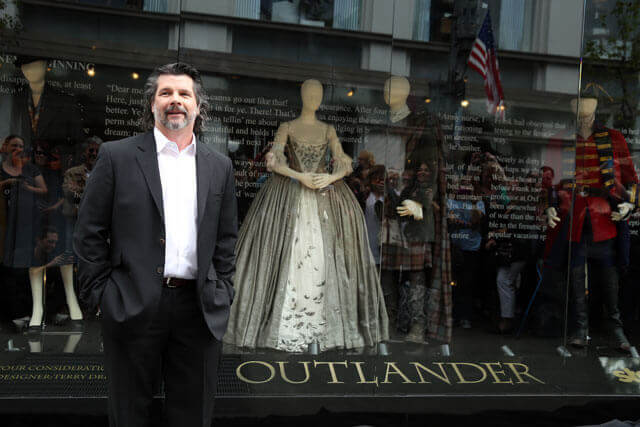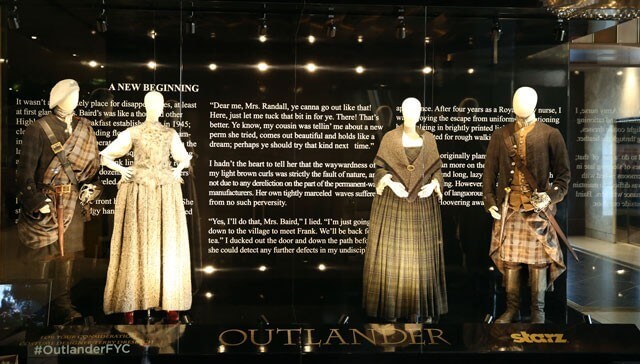
Outlander series creator Ronald D. Moore helped unveil 12 gorgeous costumes from season one of the critically acclaimed Starz series as part of the ‘A Tartan Affair’ display at The Grove Los Angeles on May 22, 2015. The display is free and open to the public and runs through May 31st, with Outlander author Diana Gabaldon scheduled to make an appearance at 2pm PT on the final day of the exhibit.
Outlander‘s beautifully detailed costumes should earn designer Terry Dresbach her second Emmy win, and fans will have the opportunity to get a close-up look at these 12 costumes to see the incredible amount of work that went into creating the clothing worn by actors including Sam Heughan (Jamie Fraser), Caitriona Balfe (Claire Randall), and Tobias Menzies (Black Jack Randall) during season one.
The costumes on display are:
· 1940s Claire and Frank Randall, Episode 101 “Sassenach”
· Jamie Fraser, Outlander Season 1
· Highlanders, Outlander Season 1
· Dougal MacKenzie, Outlander Season 1
· Black Jack Randall, Captain of the Eighth Dragoons, Outlander Season 1
· Geillis Duncan, Episode 103, “The Way Out”
· Claire Beauchamp Randall 18th Century Tartan Dress, Episode 104, “The Gathering,” 105 “Rent”
· Claire Beauchamp Randall and Jamie Fraser, Episode 107, “The Wedding”
· Geillis Duncan, Episode 111, “The Devil’s Mark “
· Redcoat Officer, Episode 106, “The Garrison Commander”
Prior to Moore’s appearance at the opening the special 10-day “Emmys For Your Consideration” display, I had the opportunity to speak with Outlander‘s showrunner/writer/executive producer specifically about the show’s authentic costumes. And while the focus of the interview was on the costumes and the finale of season one was off-limits to avoid any spoilers, I did ask Moore if he had any advice for fans as they sit down to watch this season’s final episode on May 30th.
“Not really,” replied Moore, laughing. “If you’re a fan of the books, I think you know generally what’s coming. We’ve made changes in the end like we always do, but I think it’s very much in keeping with the spirit of the books and of the characters. I think it’s a satisfying conclusion to the first season. I just hope people enjoy it.”
Ronald D. Moore Interview:
How does the process work when it comes to collaborating on a project with your wife, Terry Dresbach? I’m sure there’s a shorthand that’s developed between the two of you.
“Yeah, pretty much. She was a fan of these books at the outset and turned me on to them. She’s very familiar with the world and the characters, and she had thought a lot just in her head about how the show would look even before working on the show. And then on this, we talked very generally and conceptually at the beginning about from my point of view, just things like I really wanted to go for authenticity in the costumes and not try to reinvent the period or make them hip or edgy. Just to really go for really what people wore. I harped on things like making sure they felt lived in and looked so that you believed people actually wore these clothes.
A lot of costume dramas you feel like the clothes just come off of the truck and then they go back onto it before they get dirty. I wanted a real lived-in look. And I bitched and moaned about the colors of the Redcoats because that’s been a bugaboo of mine for years. Other than that, it was kind of like Terry just took it and ran with it. She’d show me the designs and fabrics, and it was usually just sort of me saying, ‘Wow, that’s great. Okay, I’ll go deal with the problems over here,’ because I just kind of knew that stuff was all taken care of.”
Does the comfort level of the actors come into play at all, or is it all about the look of the costumes?
“No, I think she pays a lot of attention to the comfort of the actors because she has worked in the business for a long time. Especially these kind of clothes, 18th-century clothes especially the women, there’s a lot of layers. There’s corsets and skirts and underskirts, all kinds of things. It takes a while to get in and out of these clothes so I think she’s always designing with an eye toward what’s the best way that I can maintain the look of the show but also provide the actors with the maximum amount of comfort.”
Does Diana Gabaldon have a say in the costume design?
“No. Diana sees them pretty much once they’re already shot. Diana is a consultant on the show and she sees scripts and story outlines and dailies, but she’s not really on the production per se. So, Diana sees them once we’ve already shot them.”
How do you feel about working in two very distinct time periods on the series?
“I like the double period of it all. It keeps it interesting and fresh. There’s things to learn about each of the periods that I’m always learning about and that the writers are always learning about. It’s fun. I think it keeps it engaging that you’re not just in this one place. You’ve also got the ’40s to deal with periodically or the ’30s sometimes. Going into future seasons, there will even be later periods of the 20th century.”
Backing up a bit, what was it about the Redcoat costumes that you had to make sure you got right that other productions might have gotten wrong?
“Well, one of the things that I’ve just hated when I see Redcoats on film or TV is the color. I’ve always thought that they looked bad. They’re typically sort of this candy apple red which I just think is hideous and not true. When I’ve seen portraits of British officers from the period, it has a deeper, more of a scarlet tone. So whenever I would see a movie like The Patriot or anything like that, I would always sit next to Terry on the couch and bitch and moan about it. She’s grown really tired of hearing me talk about it over the years.
So the one thing on this show that we could have rented were Redcoat uniforms, and it was only thing that I was adamant that we were not going to rent. [Laughing] She had to make all the Redcoats and dye them, and get them exactly right.”
What was the most difficult costume to get right?
“I think Terry would probably say the wedding dress because it was a wedding dress and there was going to be so much attention and focus on it. I know that the design period on that and the construction period on that was very long. It was a long gestation period. It was incredibly detailed. You know, the wedding outfit had actual small sheets of mica embedded in the fabric in a way that catches the light, so she had people in her department actually shaving pieces of mica by hand. If you look on the dress down the front, it has these silver acorns and leafs and those are all metallically embroidered by hand. That took a tremendous amount of time. I’m sure the wedding dress is probably the one that took the longest.”
Is it also the costume that has received the most comments and feedback over all?
“I think so. Because it’s a wedding dress it kind of invites comments. I think also that she did a bunch of pieces that she calls Mrs. Fitz’s bits which are knitwear pieces, and there’s a muffler and hand mittens and various knitted pieces that she’s used for Claire and some of the other female characters. I think that also got quite a bit of attention as well.”
Fans have mentioned they’d love a line of cosplay costumes based on Outlander. Do you know if anything like that is in the works?
“We’ve certainly been in discussions with Sony who has the merchandising rights and talking about different versions of the outfits for cosplay or for design patterns for fans to make. I know that that’s something that people are clamoring for and hopefully that’s something we can deliver.”
Have you heard any comments about people wanting to copy Claire’s wedding dress for their own weddings?
[Laughing] “I have heard that. It’s awesome. Terry was telling me that people were actually trying to copy it for a wedding. I never saw a picture of it actually done, but I did hear about it.”

What was the reaction of fans to seeing the costumes when they were on display in New York?
“It was pretty intense. I walked around and visited with some of them while they were going through that area. I mean, people were just fascinated with being that close to something they’d seen on television. It’s a really interesting place when a fan can get that close to something that they’ve only seen on their screen, whether it’s a prop or a costume or part of the set or a cast member. So, when they were standing there and there was Jamie’s outfit, there was Dougal’s, there’s a Redcoat, there’s the wedding dress, you could just kind of see in their eyes that they were kind of awestruck. It was really great to allow them to do that.”
As the series’ showrunner and writer, how do you deal with trying to decide what goes into the show and what doesn’t make it?
“It’s just kind of fun, I’ve got to tell you. I really enjoy my job. It takes a lot of decisions, but that’s kind of what I like to do. Your job as the showrunner ultimately is to decide what is the show and what is not the show. That’s kind of the question you answer every day from people who work for you and then the people I work for, you know, the stars and Sony. Somebody, and it’s ultimately the showrunner, says, ‘That is the show and that is not the show.’ That kind of goes right down the line. ‘That look is something we are going to do and that look is something we’re not going to do.’ That line of dialogue, that piece of editing, that sound mix, that music thing, that storyline, we’re just kind of constantly deciding internally, ‘Okay, what is the show?’
And, ultimately, as long as you have an answer for that question in your own head, you can be successful at it. And you have to also be willing to change your mind, admit when you’re wrong, and say, ‘Oh, actually that should be the show.’ Or, ‘Wow, that was a mistake. That should have never been the show.’ You just have to flexible about it.”
Does fan input or social media input play a part in that process at all?
“Not to me. Since my Star Trek days I’ve always sort of said it’s not a democracy, so I don’t really look to social media or fan sites or fan response to kind of guide me because you can get lost in that. It’s not representative on a very fundamental level, and it’s just not about letting fans vote for what they want or really listening to their desires or complaints because ultimately you still have to make a show. You have to make your own specific choices. You want them to like it; you’re hoping they’re going to like it, but you can’t really give over the direction and the vision of it to that. You have to kind of create it and then present it and hope it works.”
When you did Star Trek and Battlestar Galactica there wasn’t the ability to have instant feedback on social media the way there is now. There’s live tweeting going on during Outlander episodes. What do you think of that ability to get instant feedback on the show?
“It’s interesting. I try not to take it too seriously. It’s the closest you get most of the time as a television writer to being able to observe your audience. Most of the time in TV you watch the show with your wife or your cats or whatever, and it’s not the same as standing in the back of a theater and watching the audience react. So, social media gives you an opportunity to get a little bit of real-time response.
However, again, I’m always sort of thinking, ‘Well, but that’s a very small portion of people who are actually watching.’ I know I watch a lot of movies and TV and I’ve never gone onto social media and talked about it during or afterward. It’s a different level of engagement with the program when you’re doing that, and I think that’s great. Obviously that’s someone who cares deeply and passionately about it, but it’s a fraction of a fraction of what the overall audience is which is in the millions. You have to kind of think that it’s interesting but you just can’t take it to heart.”
Outlander fan Bonnie Terbush and the members of the Facebook group ThePeakPosse have organized fundraising drives based on the charities supported by Sam Heughan and Caitriona Balfe. You said social media input doesn’t play into the vision for the show, but do you keep up with what’s happening in that world when it concerns Outlander or the cast?
“Intermittently. [Laughing] My wife is much more in tune with it than I am. She has her own blog and tweets quite frequently. I tweet intermittently at best. She kind of will tell me what’s going on out there. Starz publicity and Sony publicity keep me in the loop and let me know what’s happening out there to just kind of keep your finger on the pulse of it, more or less.”






